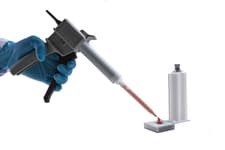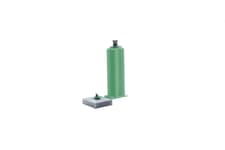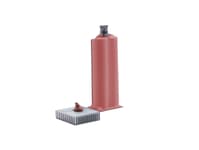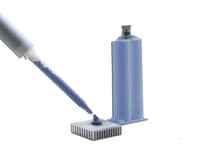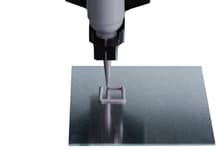One Part Hybrid
Thermal conductivity liquid gap fillers not only have the benefits of shape recovery, strong material cohesion, and good long-term thermal stability but they they also offer a very low thermal resistance comparable to thermal grease, and can fill gaps at interfaces.
Hybrid is a substance between liquid and solid, combining the advantages of thermal grease and thermal gap pad, without the potential problems of either. Thermal Hybrid is prepared as a silicone polymer, with low molecular siloxane, and mixed with high thermal conductivity particles (such as alumina, aluminum nitride powder, etc.).
Compared with thermal grease, the main difference is that thermal Hybrid does not present oil separation issues while in storage, and the Hybrid can be torn off and reused. Thermal Hybrid only needs a relatively low working pressure when connected with heat sink and chip, and has a wide working temperature range. Single part hybrid thermal gels exhibit exquisite oil bleeding properties and find some of their main applications in consumer electronics, automotive vehicle control systems, EV batteries, networking devices and applications that require horizontal mount. Used from major manufacturers, HT series products perform incredibly well with a tiny amount of material.
The HT series, our one-part hybrid Gap Filler, provides effective thermal properties and high conformability along with its high compressibility. It is formulated to deliver high dispense rates for improved productivity, long-term reliability performance and easy re-workability. It is designed to minimize thermal resistance at interfaces, maintain its performance through reliability testing, and provide scalable application at a competitive cost. All HT series products are available in 280cc aluminum cartridge, and 1 and 5-gallon pail.
HT 5010 | One part Hybrid Thermal Gel
- Gray
- 5.2 Thermal Conductivity
- Best performing mid range TIM
- 8 weeks
HT 10000-R | One part Hybrid Thermal Gel
- Dark Gray
- 10 Thermal Conductivity
- Good dispense rate
- 12 weeks
HT 11000 | One part Hybrid Thermal Gel
- Dark Gray
- 11 Thermal Conductivity
- Highest thermal conductivity
- No longer available
Product Selector Guide
| Product name | Feature | Color | Specific Gravity | Thermal Conductivity (W/m·K) | Thermal Impedance (˚C·cm2/W) | Minimum BLT (mm) | Dispense Rate (g/min) | Out Gassing (TML) | Storage Condition | Shelf Life (months) |
|---|---|---|---|---|---|---|---|---|---|---|
| HT3500 | Silicone-based Pre-cured | Dark Red | 3.2 | 3.5 | <0.35 | 0.10 | >10 | <0.5% | RT | 12 |
| HT4500 | Silicone-based Pre-cured | Green | 3.3 | 4.5 | - | - | >40 | - | RT | 12 |
| HT5010 | Silicone-based Pre-cured | Grey | 3.4 | 5.0 | <0.28 | 0.14 | >14 | <0.05% | RT | 12 |
| HT7000* | Silicone-based Pre-cured | * | * | 7.0 | * | * | * | * | * | * |
| HT9000* | Silicone-based Pre-cured | * | * | 9.0 | * | * | * | * | * | * |
| HT10000* | Silicone-based Pre-cured | * | * | 10.0 | * | * | * | * | * | * |
*Since those are top of the line products, we go to certain extends to protect Honeywell\'s IP and competitive advantages. A plethora of information, including additional data, images and samples are available once an NDA is in place. Contact us for more details. (Yes, they are exceptional)
**Typical values for electrical properties on our high end products are: Dielectric constant@1MHz: 9 and Volume resistivity: 1013Ω*cm
**Lower conductivity materials have much lower filler content and therefore have even higher volume resistivity which makes them more insulative.
Frequently Asked Questions
Can I use One part hybrid for Vertical mounting?
You can but you most likely don't want to. One part gap fillers are easily dispensable and reworkable while also requiring no mixing, additional curing or low temperature storage.
The no cure nature of the fully cross linked one part thermal gel results in relatively lower adhesion, making it less ideal for vertical applications. This changes when screws or clamps are involved in the assembly. In that case it can be a proper and effective solution. Otherwise we will suggest to take a look at our Two part thermal gap fillers, ideal for vertical application.
What are the texture of thermal hybrid gel? Are they adhesives?
They won’t be like rubbery elastomer, still gel form, not perform elastically. When you apply pressure, the gel will spread and think down. If you remove pressure afterward, it will not bounce back and turn to the original form. Among all the TIMs, only gap pad with low TC could recover back. That is also why, for gap pad, even you tear off it from the heatsink, you could still reconnect and use the same material. But for other materials, you need to remove them and apply new material again.
Thermal hybrid gel is not designed as a structural adhesive and has a low level of natural tack, which will allow the material to adhere mildly to adjacent components. This also help keeping the material in the interface throughout repeated temperature cycling and eliminates pump-out from the interface.
What are the differences between one-part and two-part hybrid gels?
Not really much in texture and thermal properties. Two part system requires multiple adapter heads for two part to mix and curing 2 hrs@RT. We always say that one-part is better to use for horizontal application but two-part hybrid is suitable for both. This is because two-part cure in place, it has better adhesion to heatsink surface.
However, you always need to get trade off between adhesion and rework-ability. So even for two-part hybrid, it is not strong adhesion, just slightly higher than one-part. For small size device (consumer electronics), you could also use one-part for both directions.
What about the maximum BLT?
That\'s an odd question since the challenge is always to achieve the thinnest bondline thickness. Maximum BLT is mostly a matter of surface area and avoiding slumping. We have tested all of our one and two part hybrid gels and can confidently say that you can reach 1-5mm maximum bond line thickness without slumping.
What are the applicable temperature range and pressure for hybrid gel?
Thermal hybrid gel products are silicone based products. All the silicone-based thermal products could be used up to 200 °C.
Hybrid gels need less 10psi to reach BLT 0.1mm – 1.0mm; but PCM needs higher pressure and suitable for 0.03-0.05 mm application
Learn More
One-part Hybrid
Hybrid is a substance between liquid and solid. Hybrid thermal gel, prepared as a silicone polymer, with low molecular siloxane, and mixed with high thermal conductivity particles (such as alumina, aluminum nitride powder, etc.). As thermal conductive liquid gap fillers, hybrid gels offer good dispensing and thixotropy properties for automated assembly processes. They not only have the benefits of conforming to complex shapes and strong material cohesion, and also good long-term thermal stability. Caplinq provides pre-cured hybrid and two-part hybrid products that require mixing and curing steps.
The key benefits of choosing thermal hybrid gel products are summarized:
| Reliability | Compared to thermal grease, the main difference is that thermal hybrid does not present oil separation issues while in storage. Compared to gap pads, there is no pump-out or cracking risk. The Hybrid can be torn off and reused. |
|---|---|
| Compressibility | High compressibility minimizes thermal resistance at interfaces, while maintaining excellent performance during reliability testing. Thanks to the ultra-low modulus, the gap filler creates minimal stress on components during the assembly process, which makes it applicable for most of the fragile and delicate devices. |
| Flexibility | Hybrid gels offer infinite thickness and shape options, and are able to conform to intricate topographies, including multi-level surfaces. They are a single solution for multiple applications. Rheological characteristics could also be adjusted to suit different requirements. |
| Productivity | Prior to curing, the material maintains good thixotropic characteristics and low viscosity to be easily dispensed. The material could be applied directly to the target surface by manual or automatic dispensing, which improve productivity and precisely control the application process with minimal wastage. |
| Feature | Hybrid Gels | Gap Pads | Putty Pads |
|---|---|---|---|
| Automation Compatibility | Easily dispensed with automated equipment; precise volume control | Typically manual placement; limited automation compatibility | Manual placement; some automation possible but less precise |
| Assembly Speed | Fast, direct dispensing onto components or substrates | Slower due to alignment and cutting | Moderate; can be pressed into place but less efficient than gels |
| Precision & Repeatability | Programmable patterns and bondline control | Subject to manual alignment variability | Conformable but less consistent |
| Conformability to Surfaces | Flows into micro-gaps under low pressure | Compressible but may trap air | Soft and pliable, but can be uneven |
| Material Waste | Exact dosing per unit, no trimming required | Cutting, trimming, and misalignment generate scrap | Excess material may need to be removed |
| Thermal Contact Quality | Superior wet-out, fewer voids | Depends on pad compression | Fills voids but may not spread evenly |
| Suitability for High-Volume Production | Ideal for robotic and automated lines | Manual handling slows throughput | Not as efficient for precision-driven automation |
The HT series is one-part hybrid gel, which is already fully cross-linked before being applied. It could save time in assembly process and has longer shelf life. The HLT series products are two-component gels that can be cured in short-time after two-component mixing at room temperature. For details process handling guide, please refer to HLT Products Application Note and HT Products Application Note products are cured in place, thus have better adhesion to components and are suitable for both horizontal and vertical applications. In total, the two series products share similar thermal and electrical properties.
One-Part Hybrid Gel Application Note
Handling methods and storage conditions
Storage conditions
• At 25 ℃ / 65% RH Storage ~1month
• At <10°C storage 6 months
Store syringe in a cool and dry ambient environment in horizontal position. Keep away from incompatible materials as outlined in the MSDS.
Do not handle, store or open the container near an open flame and/or source of heat or sources of ignition.
Keep the syringe tightly closed except when dispensing TIM.
1 hour thawing time is required after the syringe is taken out from the freezer and before dispense..
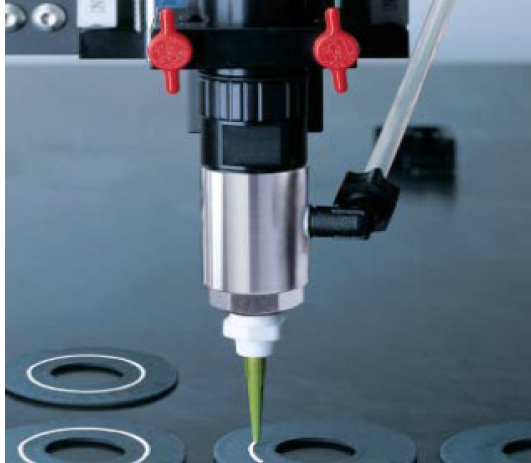
Dispense equipment
- Auto or Semi-Auto is recommended
- Air pressure or motor controlled auger screw valve
- Auto dispenser with programmable motion control for precise pattern dispensing
- Nordson EFD syringes are suggested
Dispense Nozzle/Needle Tip
- Plastic or Stainless steel
- Diameter size based actual application.
- Narrow tip nozzle for small/thin applications
- Large tip nozzle for big/thick applications

Dispense patterns
- Dot pattern: ultra small pad application 6
- Star pattern: small and square application
- Rectangular-ambulatory-plane pattern: large/thick application
- Custom design: based on actual application, coverage and surface; test validation is recommended

Angular vs Vertical Dispensing Methods
Angular and vertical dispensing are two distinct methods for applying hybrid gel thermal interface materials (TIMs) in which it differ in terms of orientation and approach used to deposit the thermal interface material onto the components.
In angular dispensing, the thermal interface material is dispensed at an angle in which the material is applied at a direction other than purely vertical. It is particularly useful for achieving precise material placement on complex and irregular surfaces and helps to minimize air entrapment and ensure conformal coverage over components with varying heights and contours. Moreover, reduces the likelihood of air bubbles or gaps forming between the component and the heat sink which improved thermal conductivity and efficient heat transfer.
While vertical dispensing, material is applied perpendicularly onto the components. It is relatively simpler and faster compared to angular dispensing which is often automated for mass production. This dispensing method is commonly applied to components with relatively flat and slightly uneven surfaces. One advantage of vertical dispensing is it allows you to have uniform thickness deposition of the thermal material.

Curing profile
HT Series TIM is a self curable material which can get fully cured under room temperature condition given enough time. Heat baking can expedite HT series TIM curing. Generally it takes about 72 hours for the One part hybrids to fully cure in room temperature, something that halves when you double the temperature and can go down to half an hour at 120°C.
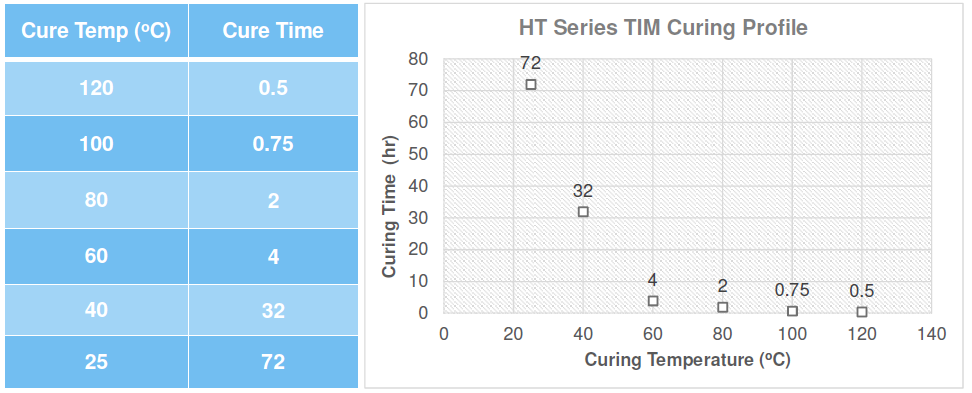
Thermal Properties Test Method
Thermal impedance test method: Cut bar
All of our product properties are tested based on strict and regulated test method standards such as the ASTM. The test method always accompanies the product properties. We try to undershoot rather than overshoot the product capabilities so that you always get at least the advertised properties (and usually much better than that). We pride ourselves in providing "spot on" stated properties.
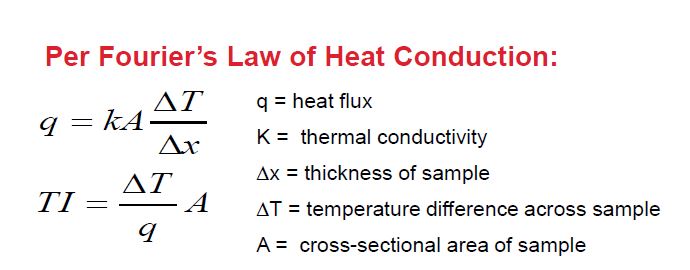
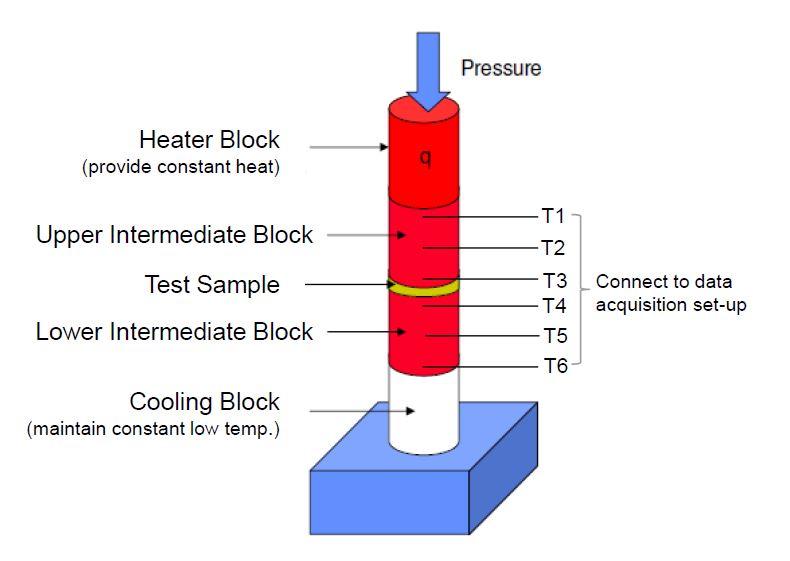
Thermal conductivity is an easy way to categorize products and it is true that this is the leading property in our product nomenclature. At the end of the day though, Thermal impedance is what makes the real difference. That\'s why most of our technical discussions revolve around these values. In order to test it we have implemented various methodologies such as the Cut bar method that is demonstrated in this image.
This methodology is based on ASTM D5470 (at the time this content was written) and is a destructive, one time test with fast and immediate results. One of the most common methodologies that we use for Thermal impedance.
Thermal impedance test method: Laser Flash
Another test, suitable for accelerated life testing, is the Laser flash method. With ASTM 1461 (current) we measure the thermal impedance between Si, Ni plated Cu surfaces.This method includes the CTE mismatch and the actual surface finish.
Laser flash takes thermal diffusivity into account and the calculation follows the logic in the image. Typical coupons used are:
- Ni plated Copper -0.5”X0.5”X0.03”
- Si - 0.5”X0.5”X0.02”
Please note that these methodologies are not strictly limited to one part hybrid thermal gels but they also extend to out entire thermal interface product line, when applicable.
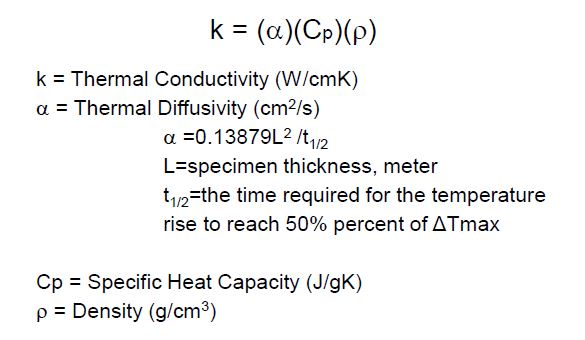
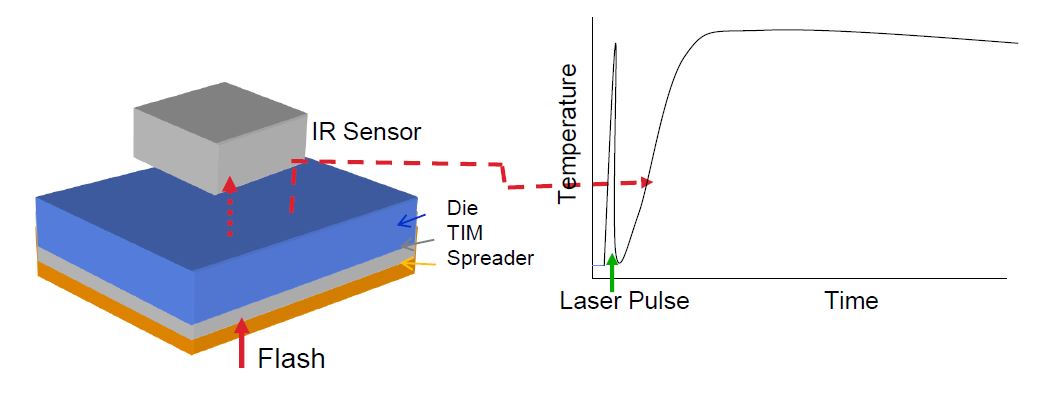
Can Hybrid Gel Technology survived >200C operating temperature?
In general, customers choose putty pads and other Hybrid Gel Technologies for their ultra-soft, compliant performance, which helps minimize stress at the interface and ensure good thermal contact. However, it's critical to understand the material's limitations, particularly under extended high-temperature exposure.
While short-term exposure to elevated temperatures such as during solder reflow processes is acceptable, long-term operation at temperatures exceeding 200°C is not recommended. Prolonged exposure at this range can cause the material to harden or degrade, potentially introducing stress or loss of thermal contact at the device level. While one-part thermal gels behave similarly to putty pads at high temperatures, they don’t carry the same hardness-related risks on putty pads and might be a more suitable alternative for >200C application.
Related Blogs

TIMs in Renewable Energy
This blog discusses the role of thermal interface materials in renewable energy sources such as solar and wind energy.



